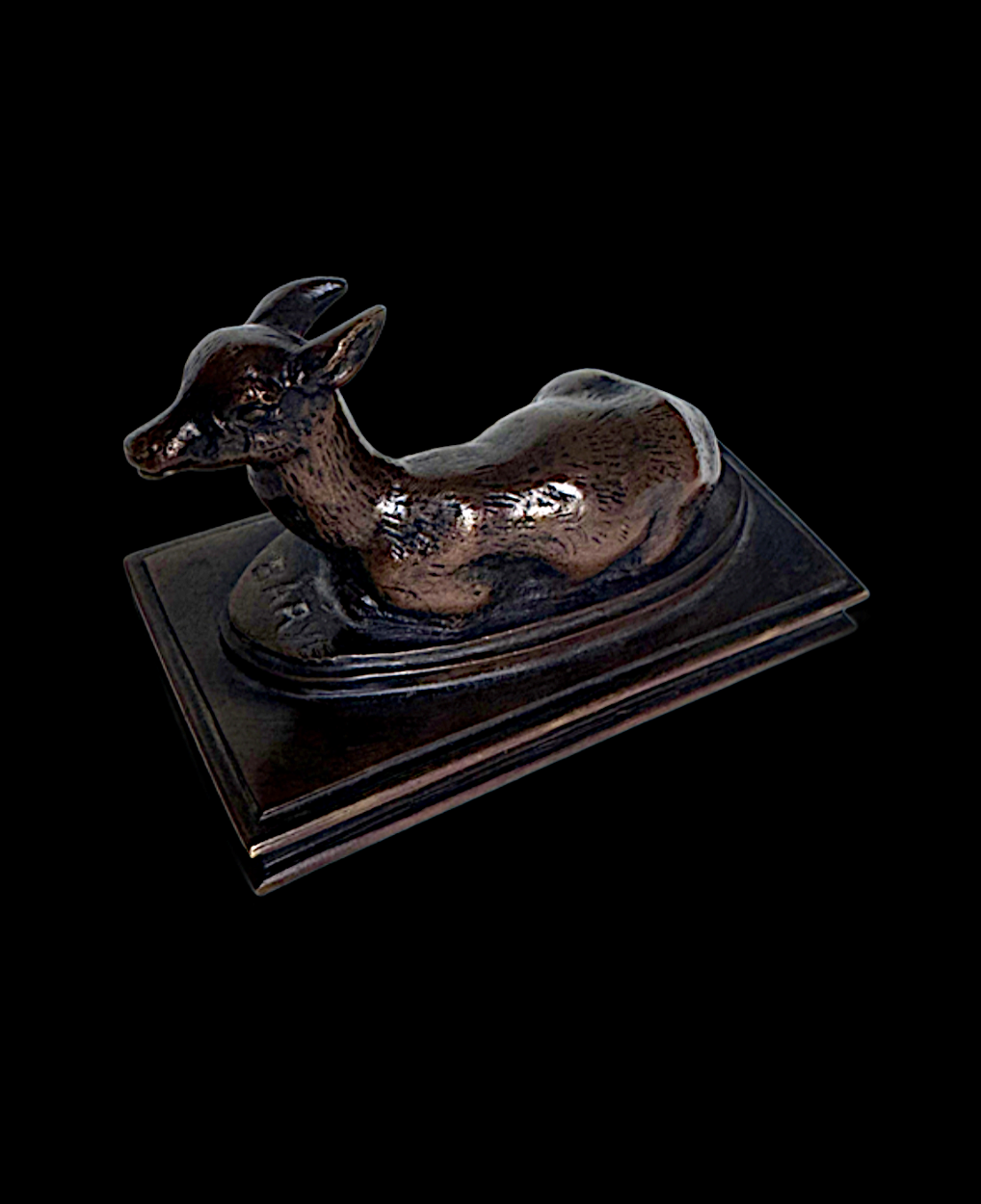

Title: Resting Fawn By Sculpture Artist ANTOINE-LOUIS BARYE
Shipping: $29.00
Artist: N/A
Period: 19th Century
History: Art
Origin: Central Europe > France
Condition: N/A
Item Date: N/A
Item ID: 1650
Sculpture artist ANTOINE-LOUIS BARYE (1796–1875). “Resting Fawn” Period: 19th century: Bronze with brown patina: Foundry: Barbedienne: Resting on a fully cast rectangular base; signed BARYE. The base features crisp detailing and a warm patina characteristic of Barye’s mid-19th-century foundry production. A similar model was recently sold in Paris, Avenue Hoche, for €3,840 (including premium). This finely detailed bronze, depicting a fawn in repose, is an early casting from the workshop of the celebrated French sculptor Antoine-Louis Barye, renowned for his animalier works. His sculptures were inspired by close observation of animals at the Jardin des Plantes in Paris. Comparable models are illustrated in The Barye Bronzes. Condition: Excellent Dimensions: L 3½ × W 2 × H 2 in Material: Bronze / In the 19th-century art scene, Antoine-Louis Barye emerged as a prominent figure, celebrated for his exceptional talent in animal sculpture. His mastery in capturing the vitality and character of animals made him one of the most sought-after sculptors of his time. While he is best known for his animalier works, Barye’s oeuvre encompassed a broader range of subjects, including mythological themes. Barye began his artistic training under his father, a goldsmith, and later studied with the masters François Joseph Bosio and Antoine-Jean Gros at the École Nationale Supérieure des Beaux-Arts in Paris, where he enrolled in 1818. Over the course of his career, he operated his own foundry, collaborated with architect Viollet-le-Duc on commissions from Napoleon III, and taught the young Auguste Rodin. A notable example of his engagement with mythological subjects is his interpretation of the Theseus legend, to which he returned on two occasions. One of these works depicts the legendary confrontation between Theseus, son of Aegeus, and the Minotaur within the labyrinth of Crete—a piece he presented at the Salon du Louvre in 1843. Antoine-Louis Barye, a master of 19th-century French sculpture, was celebrated for his dynamic animalier works and his exceptional skill in capturing movement and form. Over his distinguished career, he received prestigious commissions from Napoleon III, collaborated with leading architects such as Viollet-le-Duc, and operated his own foundry. As a respected educator, Barye also taught the young Auguste Rodin, leaving a lasting influence on the next generation of sculptors.
Biography / Antoine-Louis Barye (1796–1875) was a renowned French sculptor, celebrated for his masterful animal sculptures. His practice of sketching animals from life—often at the Jardin des Plantes in Paris—gradually led him to explore painting as well. Barye’s early training began in the workshop of Fourier, an engraver on steel who manufactured metal parts for the uniforms of Napoleon’s Grande Armée. There, Barye learned every aspect of metalworking, becoming an exceptionally skilled craftsman. In 1818, he entered the École des Beaux-Arts in Paris, where he received classical training under sculptor François Joseph Bosio and painter Antoine-Jean Gros. In 1820, he was awarded the second prize for sculpture in the Rome competition for his Cain Cursed by God. Barye rose to public attention in 1831 with his Tiger Devouring a Crocodile, a dramatic and expressive work that earned him recognition as the first Romantic sculptor and the admiration of critics. Over the following years, he produced numerous masterpieces—often on a small scale—that found their way into collections on both sides of the Atlantic. In 1833, he exhibited Lion and Serpent at the Salon, a royal commission for the Tuileries Gardens. This allegory of the monarchy crushing sedition was created just three years after the July Revolution. While critics praised his work, his colleagues were not always as welcoming. Defying the academic establishment that dominated the Institute, Barye established his own foundry and published his works himself, adopting the most advanced techniques of his era. Like many Romantic artists, he had a fascination with the exotic and the medieval, and he preferred bronze over marble, which he found too cold. From 1843 onward, his style matured, and his human figures—such as the bronze group Theseus and the Centaur Biénor—combined classical inspiration with the energy and movement characteristic of the Romantic vision. Although a Republican by conviction, Barye formed a close connection with Ferdinand-Philippe d’Orléans, for whom he created a grand table centerpiece. He later became a favorite of Napoleon III, producing monumental works such as Peace, Strength, War, and Order for the decoration of the new Louvre Palace, as well as an equestrian statue of the Emperor for the Louvre gates. Despite his unconventional approach to both business and art, which puzzled the Institute for years, Barye was finally admitted in 1868. In the last decade of his life, he enjoyed full recognition for his achievements, leaving a lasting legacy in French sculpture. If you want, I can also create a more concise museum-label version of this biography that’s optimized for public display while keeping all key historical points. That would make it sharper for galleries or publications.
Link: http://www.nytimes.com/2007/02/18/nyregion/nyregionspecial2/18njarts.html
Art Review
This Landscape Is Your Landscape
By BENJAMIN GENOCCHIO
Published: February 18, 200
most young realist artists these days paint from projected slide images of photographs, usually omitting niggling details and complexities of light and tone. This gives the work a compositional elegance, but there is also a nagging sense that the landscapes we are looking at are not quite real.
The rest of the show samples different attitudes toward landscape art today. Some of the artists draw on Pop Art for inspiration, while others reprise more traditional, academic themes of landscape and the romantic sensibility.